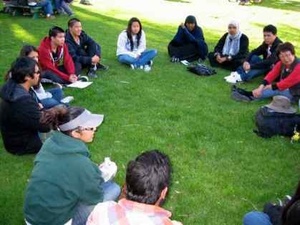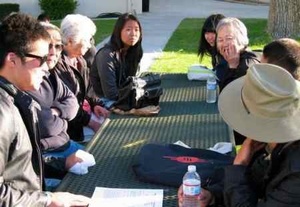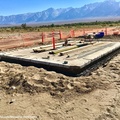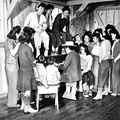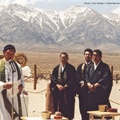Read Part 1 >>
Since MAD moved out of the VFW Hall in Independence, I felt the event lost some of its character. Fewer and fewer participants were volunteering to share during the open mic session at the end of the program, as opposed to previous years, when we would have a number of participants recite poetry they had written, inspired by their experiences that day, sing songs, play the guitar, or just share their thoughts that were inspired by what they had just experienced.
Some of that was due to the fact that students from EducationInAction at the City College of San Francisco stopped coming to the Pilgrimage and MAD after advisor Bill Sorro passed away in September 2007, but the decline began a few years before that.
The Manzanar Committee had to re-organize and scramble a bit to run the MAD program starting in 2008, and, because of that, the last few years were organized without seeking help with the program content from outside of our organization, partially due to a lack of time.
At the same time, I knew that the involvement of college students had to be restored to the MAD program. But outside of the UCLA Nikkei Student Union, some Japanese American student organizations were just beginning to discover (or re-discover) the Pilgrimage and MAD programs.
As such, we have been biding our time, so to speak, until a large enough critical mass of college students in Southern California Japanese American student organizations seemed to be committed to attending the Pilgrimage and MAD annually, and, after the 2010 MAD program, I firmly believed that 2011 would be the right time.
Looks like I guessed right.
I approached the UCLA Nikkei Student Union (UCLA NSU) back in January about organizing this year’s MAD program, and we tossed around some ideas. As it turned out, they had already had some thoughts about the fact that most of the former camp prisoners were too old to speak in front of a crowd, so how do we tell their stories at MAD?
To my delight, UCLA NSU was immediately interested and excited to work on the MAD program, and came up with the idea to research actual oral histories or interview former prisoners, and then adapt those stories to be told at the beginning of this year’s program.
Not long after they jumped on board, the UCSD Nikkei Student Union (UCSD NSU) and the Cal Poly Pomona Nikkei Student Union (CPP NSU) signed on as co-sponsors as well. Both groups have been attending the Pilgrimage and MAD in recent years.
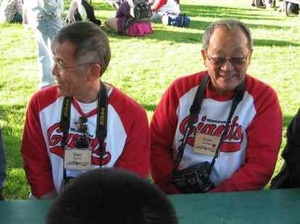
Former Japanese American concentration camp prisoners share their stories during small group discussions at the 2011 Manzanar At Dusk program. Photo: Gann Matsuda
These students ended up taking on most of the responsibilities for this year’s MAD program. Indeed, from telling the three stories of former prisoners to open the program, to having volunteers facilitating each of the twenty small group discussions, and then having student after student share their experiences during the open mic session, not to mention a duet sung by UCLA NSU’s Jaymie Takeshita and Toshi Masubuchi, it was these extraordinary college students who made the MAD program what it was this year.
While listening in on some of the small group discussions, and as I listened to comments made during the open mic session, I got the distinct sense that our crowd was more engaged by what they were experiencing than they have been since MAD was in the VFW Hall in Independence. I am firmly convinced that this was the direct result of our college students being so heavily invested in this year’s program. Their involvement meant that they were more engaged, and they brought the rest of us along for the ride.
In the end, this was, arguably, the best MAD program we’ve had in recent years.
To be sure, I was just the emcee at MAD and the logistics person this year. It was the students who took ownership of the program and decided what it would be, and, in the end, brought us back awfully close to how MAD got started back in 1997…without the campfire.
That is definitely how it should be, now, and in the future.
In the spirit of full disclosure here, I would be remiss if I failed to disclose that I had an ulterior motive in encouraging these students to get involved with the Pilgrimage and, especially the MAD program. After all, I am an alumnus of the UCLA NSU, and I always take pride in seeing an organization that gave me so much get involved in their community.
But even more important is that I remember what involvement in events such as the Manzanar Pilgrimage meant for us when I was in their shoes back in the 1980′s. We were inspired by our involvement with community organizations and activists with whom we worked because we always learned so much, and it helped develop our sense of what the Japanese American community was, and what our place was in it.
We also developed strong bonds with activists and leaders in our community, and we saw that our contributions had a strong, positive impact. We realized that our contributions were meaningful to a lot of people, making what we did meaningful for ourselves. That gave us a strong sense of pride, and helped us develop future leaders, both for our own organization and for our community.
About 25 years later, I want these young people to learn all those things we learned. I want them to learn about our community and about themselves, like we did. I want them to develop those bonds and that same strong sense of pride, and I want them to be able to develop strong future leaders.
I also want them to develop that strong sense of what our community is, that they can play a big, big role in it, and that what they do in our community now can have a tremendous, positive impact for years to come.
For them to experience all these things, just in a slightly different way or form, compared to our experiences back in the 1980’s, bodes well, not just for them, but for our community as well.
And now, hours after we’ve cleaned up after the event and locked the doors at Lone Pine High School, I can say without a shadow of a doubt that I can clearly see these incredible young people beginning to travel down the same roads we traveled back in the 1980′s. They are in the midst of a journey that looks like it will take them to those same destinations that we ended up at 25 years ago…they just look a bit different now.
Thank you to everyone from UCLA NSU, UCSD NSU and CPP NSU, especially to Matt Ichinose, Yuta Ebikawa, and Ile Rosas from UCLA NSU, Mika Kennedy and Lauren Gima from UCSD NSU, and to Ryan Kunihiro and Cameron Nakasone from CPP NSU. I can’t begin to tell you all how proud I am of what you’ve all done this weekend. Let’s keep working together and please, make sure you keep the wheels on this road…this is a road you do not want to veer away from, for any reason.
*This article was originally published on May 1, 2011 on the Official Blog of the Manzanar Committee.
© 2011 Gann Matsuda


